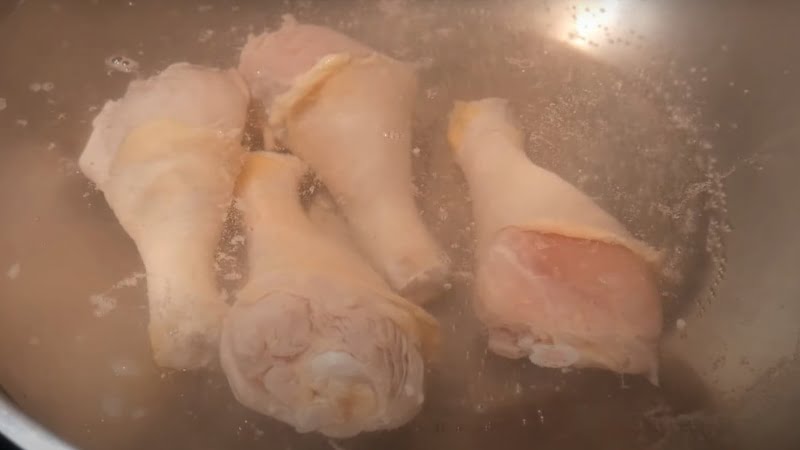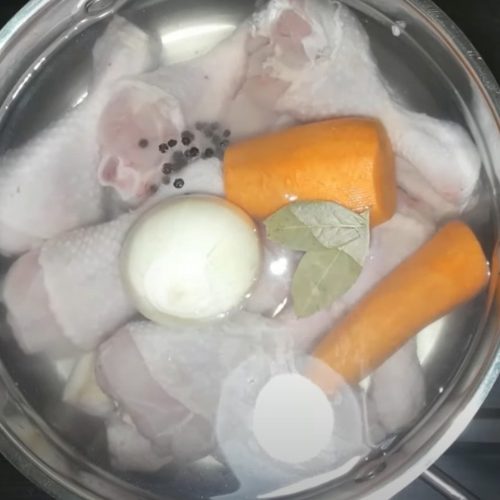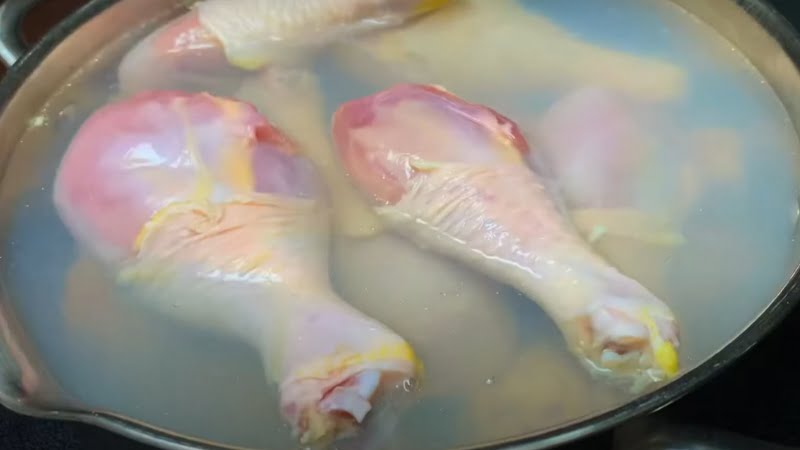Many wonder, “How long to boil chicken legs?” to achieve optimal taste and tenderness. Understanding the boiling time, whether for fresh or frozen legs, ensures they’re cooked thoroughly. This not only maintains flavor but also guarantees the chicken is cooked to perfection.
This guide will delve into the specifics of boiling chicken legs, offering insights to achieve the best tenderness and taste.
How Long To Boil Chicken Legs
Knowing how long to boil chicken legs is the first step towards achieving tender and juicy chicken. The boiling time depends on whether your bone-in chicken legs are fresh or frozen.
A detailed breakdown of boiling times
Fresh, raw chicken legs typically require 20 to 30 minutes of boiling to fully cook, ensuring the meat is no longer pink and the juices run clear. However, if you’re working with frozen drumsticks or frozen chicken legs, you’ll want to increase the boiling time to 40-50 minutes to make sure your chicken is fully cooked and ready to eat.
Factors affecting the boiling time
While the general guidelines are useful, the exact boiling time can be influenced by various factors, including the drumsticks’ size and the heat’s intensity.
Larger drumsticks, or those still attached to the thigh, may take a bit longer, while smaller drumsticks could be ready in less time. Maintaining a steady, gentle boil, rather than a vigorous one, can help ensure that your chicken legs are cooked evenly throughout, resulting in juicy chicken legs every time.

Testing Doneness Of Boiled Chicken Legs
Techniques to ensure your chicken is fully cooked
Ensuring the proper doneness when you boil frozen chicken or fresh chicken legs is crucial for taste and overall quality. One way to ensure that your chicken is fully cooked is by checking the internal temperature of the chicken.
Regardless of the size of the chicken, the internal temperature should reach a minimum of 165°F (74°C), this is similar to boiling chicken thighs. This can be checked by inserting a meat thermometer into the thickest part of the chicken leg without touching the bone.
Another technique involves observing the color and texture of the meat. The chicken should no longer be pink inside; its juices should run clear when cut. Boiling for 20-30 minutes (or 40-50 minutes for frozen chicken) on low-medium and letting the chicken simmer usually ensures tender chicken legs. However, it’s always recommended to confirm using a thermometer.
Precautions when consuming chicken
Hygiene is a paramount concern when preparing any type of poultry, and chicken is no exception. In addition to checking the internal temperature, always remember to wash your hands before and after handling raw chicken.
It’s also crucial to keep raw chicken separate from other ingredients and thoroughly cleaning any cutting boards, utensils, or surfaces the raw chicken has touched. Taking these precautions lets you enjoy your tender chicken legs knowing they are both flavorful and properly prepared.

Herbed Boiled Chicken Legs
Equipment
- 1 large pot
- 1 Meat thermometer
- Tongs
Ingredients
- 4 chicken legs fresh or frozen
- Enough water to cover the chicken legs
- 1 tablespoons of salt
- 2 tablespoons of mixed herbs such as rosemary, thyme, and oregano
- 4 cloves of garlic crushed
- 1 onion quartered
- Optional: chicken broth to replace some of the water for more flavor
Instructions
- Prepare the chicken legs before boiling. If using frozen chicken legs, ensure they are fully defrosted.
- In a large pot, combine the chicken legs, salt, herbs, garlic, onion, and enough water or chicken broth to cover the chicken legs.
- Bring the mixture to a boil over medium-high heat. Once boiling, reduce heat to a simmer.
- Let the chicken legs boil and cook for 30 minutes for fresh chicken and 50-60 minutes for frozen chicken.
- Check if the chicken is done by inserting a meat thermometer into the thickest part of the leg, not touching the bone. It should register at least 165°F (74°C). The meat should be white, and the juices should run clear.
- Once done, remove the chicken legs with tongs and let them rest for a few minutes before serving. Serve with boiled vegetables, rice, or any side dish you choose.
How to Use Leftovers
Leftover boiled chicken legs can be a great time-saver for busy weeknights. They can be shredded and added to salads and pasta or used as a filling for tacos or sandwiches. They can also be combined with veggies and some broth to make a quick chicken soup. Remember to store leftovers in an airtight container in the refrigerator and consume them within 3-4 days.
Tips And Tricks For Perfectly Boiled Chicken Every Time

Expert tips for ensuring tender, flavorful chicken
Knowing how long to boil chicken legs is a key part of the process, but there are other tips for boiling chicken that can help you achieve tender and flavorful results every time.
- Season well: Season your chicken legs thoroughly before boiling. This can include salt, pepper, herbs, and other spices. You can also boil the chicken in a mixture of water and chicken broth for added flavor.
- Avoid overcrowding: When you place the chicken in your pot, ensure enough room for the water or broth to circulate each piece. Overcrowding can lead to uneven cooking.
- Maintain a steady simmer: Once you bring the mixture to a boil, reduce the heat to maintain a gentle simmer. A rolling boil can make the chicken tough.
- Check for doneness: Boil for 30-60 minutes or until chicken reaches an internal temperature of 165°F (74°C). Checking doneness is especially important when dealing with larger pieces like chicken leg quarters.
Common mistakes to avoid when boiling chicken
Avoiding common mistakes when boiling chicken legs can also improve the quality of your cooked chicken.
- Skipping the rinse: Always rinse your chicken legs before cooking to remove any residue. Pat them dry to prevent water from diluting the flavor.
- Skipping the rest: Allow your boiled chicken legs to rest for a few minutes after cooking. This allows the juices to redistribute throughout the meat, producing a more moist and flavorful result.
- Improper storage: If you’re not eating the boiled chicken legs immediately, cool them quickly and store them in a tightly sealed container in the refrigerator. Store boiled chicken legs within two hours of cooking.
- Removing the skin before boiling: If you’re concerned about fat content, removing the chicken skin before boiling can be tempting. However, the skin helps to keep the meat moist during cooking. Consider removing it after cooking instead.
By applying these tips and avoiding common mistakes, you can make boiled chicken that is tender, tasty, and perfectly cooked every time.
FAQs
How long to boil chicken legs before grilling?
To guarantee a moist and flavorful grilled chicken meal, pre-boil the chicken legs for about 15 minutes. This step ensures the legs are cooked through and retain their juiciness, leading to a delightful grilling experience.
Will chicken get more tender the longer you boil it?
Yes, the tenderness of chicken does increase with prolonged boiling. Nevertheless, if the chicken’s internal temperature surpasses 165°F, further boiling could cause it to become tough and rubbery.
Is boiled chicken done when it’s white?
Once boiled, the chicken’s interior should be consistently white, and the juices should run clear. If these conditions are met, and the meat isn’t overly dry, it’s likely well-cooked! The internal temperature should ideally be close to 165°F (73.9°C), with 163°F (72.7°C) being acceptable as well.






![What To Pair With Quiche? 25+ Best Dishes [With Pictures]](https://www.edithsbistro.com/wp-content/uploads/2024/04/what-to-pair-with-quiche-160x90.jpg)
